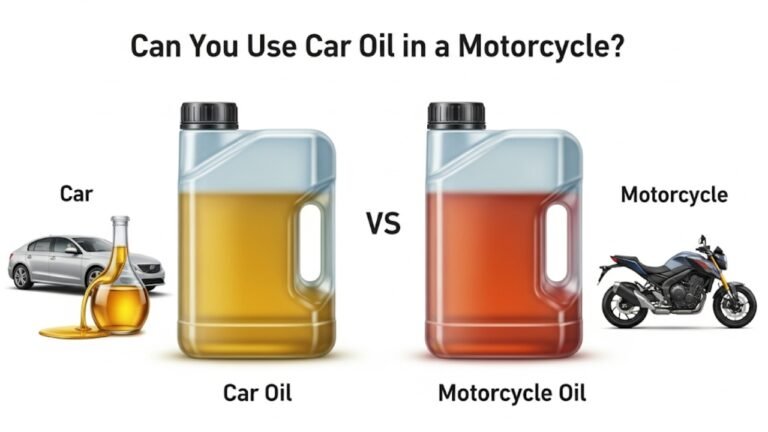Effects of Using Wrong Oil in Car

Ever poured the wrong oil into your car by accident? Trust me, you’re not alone. It feels like a small slip, but the effects of using wrong Oil in Car can quietly wreak havoc. I made this mistake once on a road trip. We were far from home, in the middle of nowhere. My car was running low, and the local shop only had limited options. I grabbed what I thought would “do the job.” Big mistake.
Cars today are sensitive. They’re like finely-tuned instruments, and engine oil is the lifeblood. Using the wrong one might not blow your engine tomorrow, but slowly and surely, it begins to damage it from the inside. This article will walk you through the real-life consequences, the science behind it, and how to avoid this all-too-common mistake.
Loss of Engine Efficiency: Sluggish and Tired

When you use an oil that’s too thick (high viscosity), it doesn’t flow properly at low temperatures. This means your engine has to work harder to pump it through. That leads to increased fuel consumption, sluggish acceleration, and just a generally rough ride. On the other hand, if it’s too thin, it fails to coat and protect the metal parts—causing faster wear and more friction.
You’ll start noticing that the engine doesn’t purr like it used to. It struggles, especially in colder weather or when idling in traffic. You might even hear ticking noises or feel slight vibrations. These are your car’s way of whispering: “Help me out here.”
Effects of using wrong Oil in Car include long-term damage that starts with poor performance. Over time, that small mistake can shave years off your engine’s life. Don’t ignore it.
Increased Engine Wear and Tear: The Silent Killer
Think of oil as your engine’s personal bodyguard. Its job is to fight off heat, friction, and grime. But when you pour in the wrong kind? That bodyguard shows up unarmed.
One of the worst effects of using wrong Oil in Car is premature engine wear. Imagine the delicate metal parts grinding against each other without enough cushion. Over time, those parts—your pistons, bearings, valves—start to wear down. That’s not just a maintenance issue; it’s an expensive problem waiting to explode.
I’ve had a friend who went a whole year using 10W-40 in a car that required 5W-20. It didn’t seem like a big deal at first. But then came the knocks, the oil leaks, and finally, a full engine rebuild. That’s a bill no one wants to see.
Here’s the breakdown:
| Correct Oil | Wrong Oil | What Happens |
| Proper lubrication | Poor lubrication | Friction increases |
| Optimal flow | Delayed flow | Overheating |
| Metal protection | Incomplete coverage | Metal-on-metal contact |
Your car’s engine has tight tolerances, especially in modern vehicles. A slight difference in oil type can cause misalignment, micro-scratches, and carbon buildup. It’s a domino effect, and once it starts, it’s hard to stop.
So if you think oil is just oil, think again. Every bottle has a job. Use the wrong one, and you’re risking everything under the hood.
Oil Leaks and Gasket Damage: The Sticky Surprise
This one’s sneaky. You don’t usually see it coming—until your garage floor is stained and you’re topping up oil more often than filling up gas.
Using the wrong oil can cause oil leaks, especially if it’s the wrong viscosity or contains additives that aren’t compatible with your engine’s seals. The gaskets and seals in your engine are designed to expand and contract with the right kind of oil. Throw in something different, and you’re asking for trouble.
I had an older Honda once, and I used synthetic oil when it clearly needed conventional. Within a month, there were spots on my driveway and a faint burning smell every time I parked. Turns out the synthetic oil was too slippery for the old seals—it started seeping through the cracks.
Here’s what to watch out for:
- Burning oil smell
- Visible leaks under the engine
- Decreased oil levels after short drives
- Smoke from the exhaust
Not only does it make a mess, but it also risks oil starvation. That means parts are running dry, leading to increased friction, heat, and breakdown.
The effects of using wrong Oil in Car don’t just stay inside the engine—they leak out, literally. And once the seals are compromised, repairs can cost hundreds or even thousands.
Poor Fuel Economy: Your Wallet Takes a Hit
Here’s where the damage hits you right in the bank account. You might not notice a rough engine or a leak right away, but you’ll definitely notice that you’re visiting the gas station a lot more often.
The wrong oil affects how efficiently your engine runs. When your car has to work harder to circulate oil or deal with added friction, it burns more fuel to maintain power. Even a small mismatch—like using 10W-30 instead of 5W-20—can cut your fuel economy by up to 3-5% over time.
Let’s break it down:
- Higher friction = more resistance
- More resistance = more fuel needed
- More fuel = more money spent
It’s frustrating because it’s such an easy thing to avoid. I remember switching oils during a cold winter just because the shop was out of stock. My car went from 32 MPG to 27. That adds up quickly, especially for long commutes.
And let’s be honest, with rising fuel prices, every drop matters. Don’t let something as simple as oil choice drain your wallet. The effects of using wrong Oil in Car hit where it hurts the most—your pocket.
Emission Failures and Environmental Impact: Hidden But Harmful
We don’t often think about the environmental cost of our car maintenance habits. But using the wrong oil can affect not only your engine but also the air we breathe.
Modern engines are built to meet tight emission standards. The right oil helps them run clean and smooth. The wrong one? It can throw off the whole system. Here’s how:
- Incomplete combustion
- More carbon deposits
- Dirty sensors and filters
- Increased exhaust emissions
Your catalytic converter and oxygen sensors get confused when the oil isn’t burning or lubricating as expected. This can trigger your check engine light and, worse, cause your car to fail an emissions test.
I had this happen during a mandatory inspection. I had switched to a cheaper oil brand and thought nothing of it. But my car failed the emissions test due to high NOx levels. It wasn’t until the mechanic asked about my oil that I realized the connection.
Not only is it bad for the environment, but it also risks government fines, repair costs, and in some cases, losing your registration until it’s fixed.
So if you care about the planet—or just don’t want surprise repair bills—the message is clear: choose the right oil for your car.
Engine Overheating: When Things Get Too Hot to Handle
Oil isn’t just for lubrication—it’s also your engine’s cooling partner. Along with coolant, oil helps pull heat away from the metal components that are constantly moving and generating friction. When you use the wrong oil, especially one that’s too thick or lacks the correct additives, heat starts to build up in the engine.
Picture this: you’re cruising on a hot summer day, windows down, music up. But under the hood, the wrong oil is causing chaos. The heat has nowhere to go, the metal parts are expanding more than they should, and before you know it, that temperature needle starts creeping up.
I’ve felt that panic. Once, after switching oil types between brands without paying attention to the specifications, my dashboard started flashing. I had to pull over with smoke creeping from the hood. The culprit? An oil with poor heat transfer capability.
Effects of using wrong Oil in Car include serious overheating risks, and when an engine overheats, damage follows fast—warped cylinders, blown head gaskets, and cracked blocks. That’s not just a problem; that’s an emergency.
Voided Warranty: A Mistake That Comes With a Price Tag
You might think oil is a small thing—something you can improvise or adjust. But for your car manufacturer, it’s a big deal. In fact, using the wrong oil is one of the fastest ways to void your car’s warranty.
When you bought your car, it came with a maintenance guide that specified what oil to use. That recommendation isn’t a suggestion—it’s a requirement. If anything goes wrong and the dealership finds out you used an oil that wasn’t approved, they can deny coverage. That means any engine repairs will come out of your own pocket.
Here’s a story that still stings. My cousin had a nearly new SUV, still under warranty. He was doing his own oil changes to save money. He picked an oil that was “close enough” to the recommended grade. When engine trouble hit at 25,000 miles, the dealership asked for his oil change receipts and specs. Just like that, he was stuck with a $4,200 repair bill.
Effects of using wrong Oil in Car aren’t just mechanical—they’re financial and legal. Always read the label, stick to manufacturer specs, and save those receipts.
Real-Life Consequences: Stories That Hit Close to Home
Let’s take a breather from all the technical talk and get real. If you think this is just a theoretical issue, think again. The effects of using wrong Oil in Car are felt by real people, every day.
- Jake from New York changed his oil himself and used a racing oil for his daily commuter. Within weeks, he started hearing engine knocks. Turns out, the high-performance oil wasn’t meant for long idle times or short drives. Result? Damaged pistons.
- Amira in Texas used synthetic oil in her older Corolla. Her intention was good—“It’s more advanced, right?” But it was too thin for her old seals. She ended up with leaks, low pressure, and the heartbreak of selling her beloved car early.
- Leo, a mechanic in California, shared that 40% of engine issues he sees are related to improper oil changes—wrong viscosity, wrong type, or poor-quality brands.
The damage isn’t always instant. It builds. Like slow rot behind a wall. Until one day, your car sputters, coughs, or won’t even start.
How to Choose the Right Oil Every Time
Now that we’ve covered the risks, let’s talk about prevention. Choosing the right oil doesn’t need to be confusing. Here’s a simple checklist to get it right:
Step-by-Step Oil Selection Guide:
- Check the Owner’s Manual
Look for the recommended viscosity (like 5W-20 or 0W-30) and oil type (synthetic, conventional, or blend). - Match the Climate
Colder weather? Choose an oil that flows better at low temperatures. Hot climate? Go for higher thermal resistance. - Stick with Trusted Brands
Don’t go for “bargain bin” oil. Choose brands that meet API and SAE certifications. - Avoid Unverified Online Recommendations
Forums are great, but stick to what your car manufacturer suggests. - Know Your Engine Age
Older engines may need thicker oils. Newer engines often need lighter, low-friction oils.
Here’s a quick comparison table to help you out:
| Car Type | Recommended Oil | Why It Works |
| Small Sedan | 5W-20 or 0W-20 (Synthetic) | For fuel efficiency and quick flow |
| SUV/Truck | 5W-30 or 10W-30 | Handles heat and heavy loads |
| Sports/Performance | 0W-40 or 5W-50 | High-temp tolerance |
| Older Models (>10 yrs) | 10W-30 or 10W-40 | Thicker to protect worn parts |
Choosing the right oil is like choosing the right pair of shoes—it should fit your car, your driving habits, and your local conditions.
Simple Habits That Save Your Engine
Let’s round this out with habits that protect your car, especially after you’ve learned how bad the effects of using wrong Oil in Car can be.
Keep These In Mind:
- Stick to a Regular Oil Change Schedule
Every 3,000–5,000 miles or as advised in your manual.
- Always Double-Check Before a DIY Oil Change
Look up the correct oil type, and don’t rely on memory.
- Keep Your Receipts
If anything goes wrong, this will be your proof for warranty.
- Listen to Your Engine
Sounds weird? Feel vibrations? See leaks? Check your oil.
- Don’t Mix Different Oils
Combining different viscosity grades can confuse your engine and reduce performance.
These aren’t just rules—they’re life-saving for your engine. Make them part of your routine.
Conclusion: One Small Mistake, Big Consequences
At the end of the day, your car doesn’t ask for much—just a little care, clean fuel, and the right oil. But when we skip the details, take shortcuts, or ignore recommendations, the effects of using wrong Oil in Car show up fast—and sometimes, at the worst possible time.
Whether it’s reduced fuel economy, overheating, oil leaks, or voided warranties, the cost is always higher than just doing it right from the start.
I’ve been there, and maybe you have too. But now you know what to watch for, what to avoid, and most importantly, how to fix it before it gets worse. So the next time you’re buying oil or heading to your mechanic, take that extra minute. Read the label. Double-check the specs. Your engine—and your wallet—will thank you.






